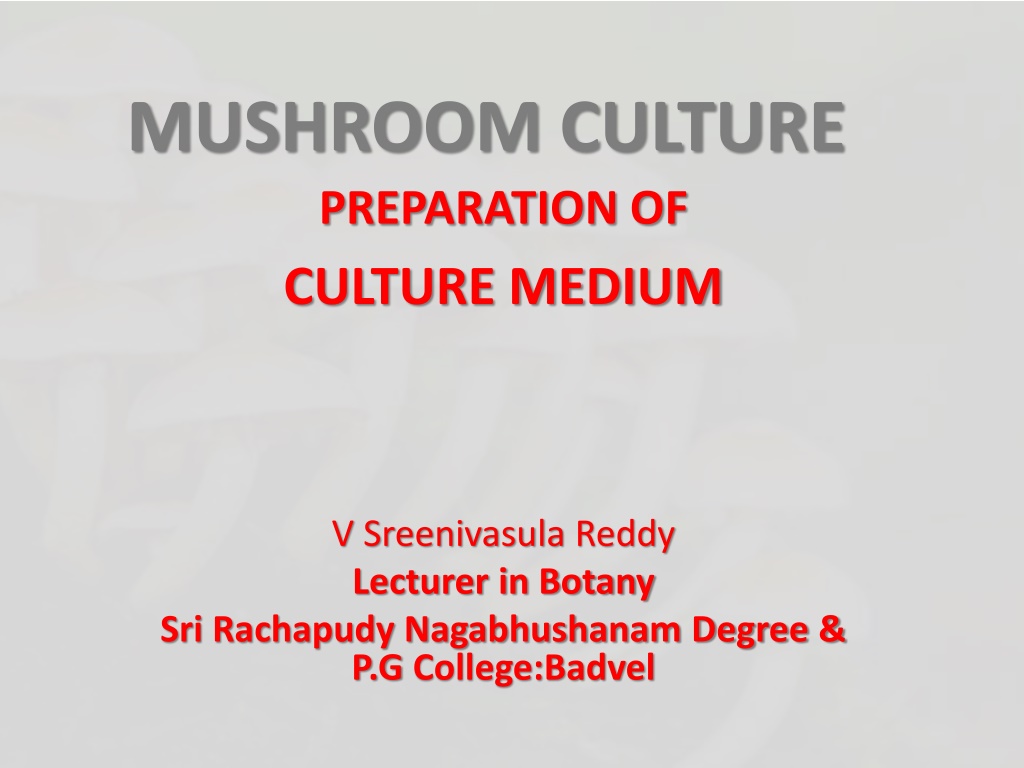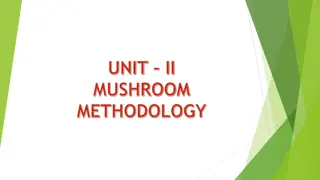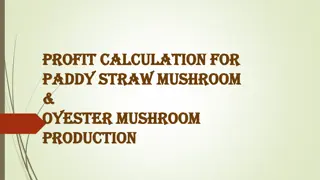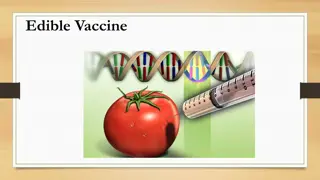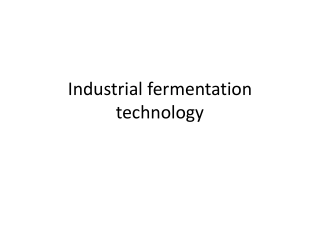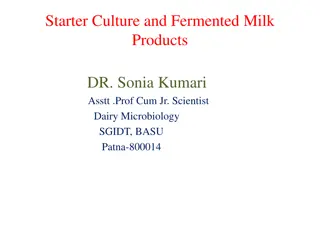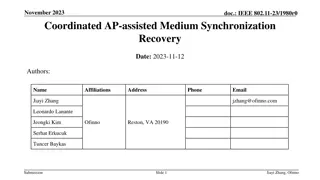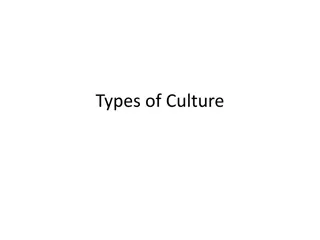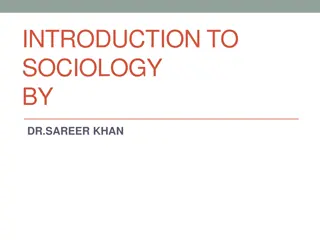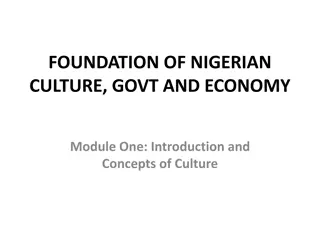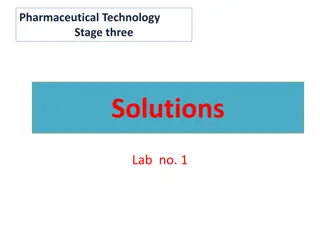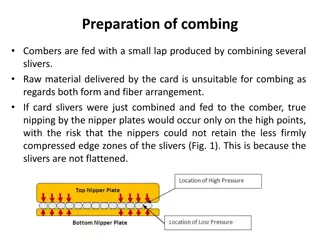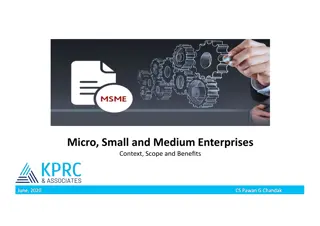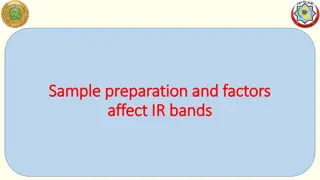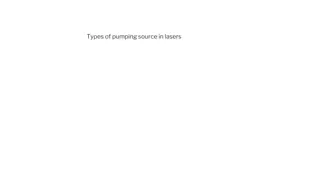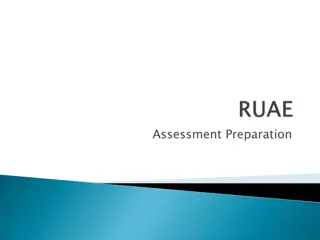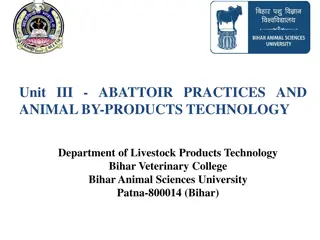Mushroom Culture: Preparation of Culture Medium and Edible Mushroom Examples
Mushroom culture involves the preparation of culture medium for cultivating various edible mushrooms. This process includes the systematic classification, structure, and examples of edible mushrooms. The medium preparation methods and materials are essential for successful mushroom cultivation. The diverse varieties of edible mushrooms such as White Button, Oyster, Shiitake, and more are highlighted in this informative content.
Download Presentation

Please find below an Image/Link to download the presentation.
The content on the website is provided AS IS for your information and personal use only. It may not be sold, licensed, or shared on other websites without obtaining consent from the author. Download presentation by click this link. If you encounter any issues during the download, it is possible that the publisher has removed the file from their server.
E N D
Presentation Transcript
MUSHROOM CULTURE PREPARATION OF CULTURE MEDIUM V Sreenivasula Reddy Lecturer in Botany Sri Rachapudy Nagabhushanam Degree & P.G College:Badvel
MUSHROOM CULTURE PREPARATION OF MEDIUM INTRODUCTION SYSTEMATIC POSITION & STRUCTURE EXAMPLES OF EDIBLE MUSHROOMS PREPARATION OF CULTURE MEDIUM MATERIALS & METHODS OF PREPARATION OF CULTURE MEDIA
MUSHROOM CULTURE PREPARATION OF MEDIUM INTRODUCTION A mushroom or toadstool is the fleshy, spore-bearing fruiting body of a fungus, typically produced above ground, on soil, or on its food source. Mushroom is an interesting modification of fungal form of life. They are non-green fungal plants occurring seasonally in many parts of the world in various habitats ranging from sandy plains to tropic forests and green meadows to roadsides. There are more than 2000 edible species of which only a few have been brought under cultivation on commercial scale
MUSHROOM CULTURE- PREPARATION OF MEDIUM Classification of Mushrooms. Mushroom is a fleshy fruiting body of some fungi arising from a group of mycelium buried in substratum. Most of the mushrooms belong to the Sub- Division: Basidiomycotina and a few belong to Ascomycotina of Kingdom-Fungi. Structure of a mushroom. The mushroom is composed of an underground part (mycelium) and an aboveground, often edible part that is also the reproductive organ called Basidiocarp . he fruiting body may contain a cap, stalk, ring, volva, and gills. The cap normally houses the spore producing surface of the fruiting body. Mushroom spores are produced on the gill of the cap of the mushroom. There are microscopic and similar to seeds of higher plant life. Spores are used to spawn mushroom compost
MUSHROOM CULTURE - PREPARATION OF MEDIUM Various stage of mushroom development (right) and mature, haploid basidiospores on basidia on the surface of the lamella.
Mushroom Life Cycle
MUSHROOM CULTURE - PREPARATION OF MEDIUM Edible mushrooms are the fleshy and edible fruit bodies of several species of macrofungi . They can appear either below ground (hypogeous) or or above ground (epigeous) 1. White Button Mushroom (Agaricus bisporus) ; This mushroom may be known as common mushroom, button mushroom, white mushroom, cultivated mushroom, table mushroom, and champignon mushroom. 2. Oyster Mushroom ((Pleurotus ostreatus) 3. Volvariella volvacea (paddy straw mushroom or straw mushroom) 4. Shiitake (Lentinula edodes) 5. Chanterelle (Cantharellus cibaris, C. formosus, etc) 6. Enokitake (Flammulina velutipes) etc
Preparation of Culture Media Culture media are essential for isolation of mushroom fungi and maintaining them in a pure culture either in test tubes or in Petri plates. The fungal cultures may be grown in liquid media (broths) or on solid agar media. ( Agaragar is a solidifying material obtained from sea seed weed like Geladium sp., which melts on boiling and solidifies upon cooling). Some of the commonly used media are listed below: Potato Dextrose Agar agar Distilled water 1000 ml. (pH : 7) 250 g 20 g 20 g i) Potato dextrose agar (PDA) :
MUSHROOM CULTURE - PREPARATION OF MEDIUM ii) Oatmeal agar (OA) Oatmeal 30 g Agar agar 20 g Distilled water 1000 ml. (pH : 7) iii) Wheat meal agar (WMA) Wheat grain 30 g Agar agar 30 g Distilled water 1000 ml. (pH : 7)
MUSHROOM CULTURE- PREPARATION OF MEDIUM iv) Malt extract agar (MEA) Malt extract 25 g Agar agar 20 g Distilled water 1000 ml. (pH : 7) v) Yeast potato dextrose agar (YPDA) Yeast granules Potato Dextrose Agar agar Distilled water 1 g 200 g 20 g 20 g 1000ml (pH: 7)
MUSHROOM CULTURE - PREPARATION OF MEDIUM Potato dextrose agar (PDA): Potato dextrose agar medium is very commonly used for isolation of fungus as well as for its maintenance Procedure: Wash 250 g potato, peel off the skin, and slice them into small pieces. Cook the sliced potato in 500 ml. water for 30 minutes in an open vessel or pressure cooker for 20 minutes. Simultaneously mix 20 g agar with 500 ml. of water and boil in a cooker for 30 minutes.
MUSHROOM CULTURE - PREPARATION OF MEDIUM Collect the potato extract by filter through muslin cloth or net filter. Add 20 g dextrose to the potato extract Mix thoroughly the molten agar with the potato- agar mixture and make the volume to 1 litre with distilled water. Check the pH of the medium using pH papers. Pour the medium in to cleaned boiling tubes @ 15 ml / tube and plug with non- absorbent cotton wool. Arrange the tubes in a wire basket, cover it with a waste paper sheet and tie tightly with a cotton thread. Sterilize them in an autoclave or a pressure cooker at 15 lbs pressure for 20 minutes.
MUSHROOM CULTURE - PREPARATION OF MEDIUM Take out the sterilized tubes after releasing the steam and keep them in a slanting position to get agar slants. After solidifying, the tubes are arranged in a wire basket and stored in a clean room for further use. Procedure for checking pH: Stir the medium with a glass rod and take a small bit of pH indicator paper and dip it in the medium. Check it with indicator. If pH is above 7, add a few drops of 0.1N Hydrochloric acid (HCl), stir well and again check the pH for neutral. Contrastingly, if the pH of the medium is below 7, add a few drops of 0.1 N Sodium hydroxide (NaOH) to increase the pH to 7
Boiling agar Potato extract + agar+ sugar Boiling potatoes Pouring in Petri plates Sterilization PDA media
2. Potato -dextrose Yeast Agar Medium ( PDYA ) Just like preparation of PDA , PDYA can be prepared by adding 2g Yeast extract in the solution for selected fungi . 3. Malt Extract Agar medium ( MEA ) Malt extract ---- 25 g Agar- agar powder ---- 20 g Distilled water ---- 1000 ml ( pH 7.0 ) Malt extract and agar are mixed in 1 litre water and boiled by continuously stirring with a glass rod so as to avoid formation of clumps.
4. Compost Extract Agar medium ( CEA ) Pasteurized compost ---- 150 g Agar agar powder ---- 20 g Water ---- 1000 ml ( pH ----7.0 ) Compost is boiled in 1.5 to 2.0 litre water for few minutes till volume of the water is reduced to half and after filtering through muslin cloth, the volume is again made to 1 litre and autolclaved after mixing agar powder in it and filling in the test tubes 4. Compost Extract Agar medium ( CEA ) Compost is boiled in 1.5 to 2.0 litre water for few minutes till volume of the water is reduced to half and after filtering through muslin cloth, the volume is again made to 1 litre and autolclaved after mixing agar powder in it and filling in the test tubes. . Pasteurized compost ---- 150 g Agar agar powder ---- 20 g Water ---- 1000 ml ( pH ----7.0 )
5.Malt Peptone Grain Agar Medium ( MPGA ) Malt extract ---- 20 g Rye or Wheat grains ---- 5 g Yeast ( Optional ) ---- 2 g Agar-agar powder ---- 20 g Peptone ---- 5 g ( pH -7.0 ) Wheat or rye grains are boiled in water for 1-1.5 hours, the filterate is mixed with other ingredients and continuously stirred while heating before filling and autoclaving.
Agar Agar Malt Extract Auto clave Slant
Preservation and storage of culture Proper maintenance of pure cultures of cultivated mushroom is necessary to maintain vigour and productivity. There is no satisfactory way to check and evaluate the qualities of spawn by any rapid on the spot examination. The strains of cultivated mushroom must be suitably preserved and carefully tested from time to time for vigour and productivity. Conventional methods of culture preservation Periodic transferStock cultures are maintained by periodic transfer on a suitable solid substrate or natural/semi -synthetic agar media. Isolation Pure cultures are raised by using single or mass basidiospore isolation or tissue culture technique from freshly harvested fruit bodies.
Ref: http://agridaksh.iasri.res.in/html_file/mushroom/05Mush_spawn_Prod.html C:\Users\Administrator\Downloads\Documents\20435969Chapter_13_3.pdf http://www.mykoweb.com/articles/cultivation.html http://www.theeducators.co/2018/01/23/mushroom-substrates-preparation/ https://www.shroomery.org/forums/showflat.php/Number/4514858 http://agropedia.iitk.ac.in/content/mushroom-spawn-production-technology https://www.orfonline.org/research/climate-change-and-food-security-in-india http://ecoursesonline.iasri.res.in/mod/page/view.php?id=103107 http://agritech.tnau.ac.in/farm_enterprises/Farm%20enterprises_%20Mushroom_Mot her%20spawn.html
